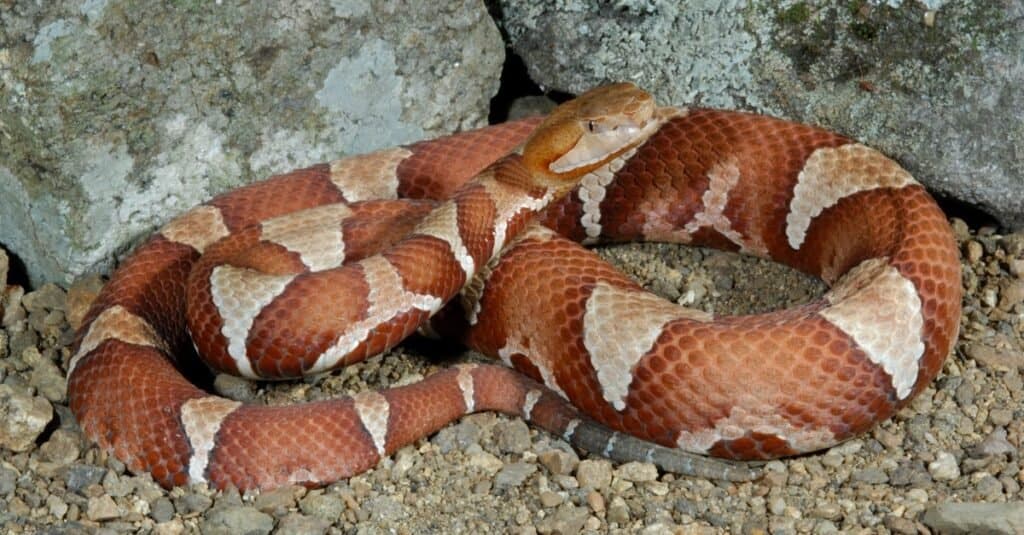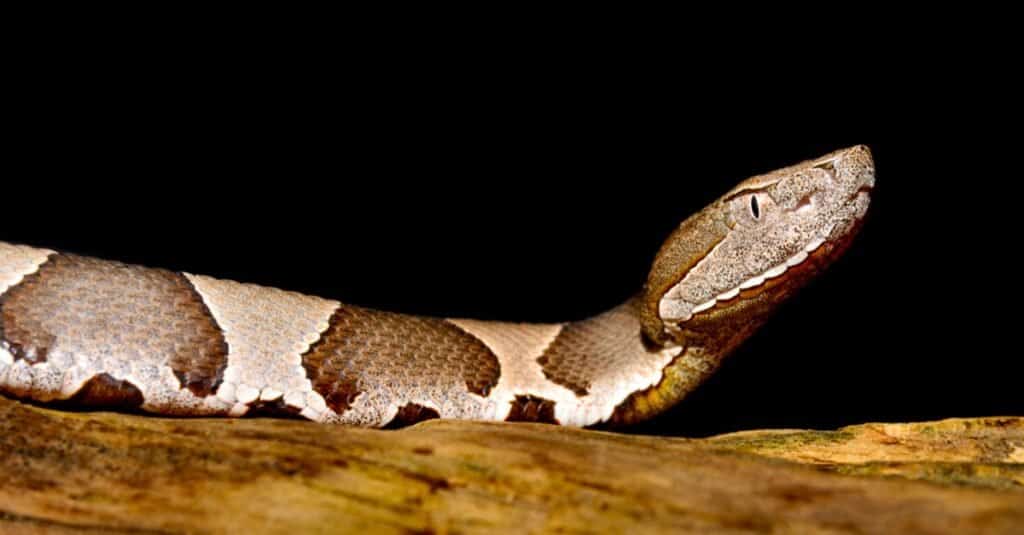Unsurprisingly, copperheads got their name from their bronze-colored heads. They can grow as long as 36 inches (90 cm), which may not be too intimidating. Yet, they possess venom that will give you a pause to think before touching or handling one. But are copperheads poisonous or dangerous? These snakes are highly venomous, and they are known to bite when provoked or threatened. These North American serpents are accountable for the most venomous bites across the United States, although their venom is rarely fatal. Copperheads are among the most feared snakes, along with cottonmouths (water moccasins) and rattlesnakes, as they are known to be highly venomous and dangerous. Although rare, copperheads still contribute a little to the snakebite deaths each year, so people must be very cautious around these snakes.
Copperhead Bites

Copperheads will bite when threatened.
©Jay Ondreicka/Shutterstock.com
Copperheads are not known to be aggressive. However, when they are threatened or provoked, they will bite. They have venom glands and sharp fangs that release and deliver hemotoxic venom, which breaks down red blood cells. The copperhead’s venom may not be the most potent of all snake species, but it can still cause severe symptoms like cottonmouth or a rattlesnake. Copperhead bites rarely lead to death, but severe complications resulting from the bite can sometimes be fatal.
Like a venomous snake, the copperhead has long, sharp fangs that help capture and kill its prey. The length of their fangs protruding from their upper jaw depends on the size of the copperhead. The bigger the copperhead is, the longer its fangs are. Copperheads use their fangs to bite and deliver venom to their prey. Because their venom is hemolytic, it causes red blood cell breakdown in its victim. Although humans are not a regular part of their diet, they can still bite people when provoked. Most incidents reported are accidental bites – where a copperhead bites someone for accidentally stepping on it.
Fortunately, the copperhead venom is not as potent as other venomous snakes, so they are not always fatal. Yet, people with weaker immune systems, such as the elderly, children, and less healthy people, risk developing allergic reactions and severe symptoms from a copperhead bite. A bitten individual must be observed for symptoms from minutes to hours after the bite.
Copperhead bites exhibit almost the same symptoms as other pit viper snake bites, which include:
- Weakness
- Immediate pain on the bite site
- Rapid swelling
- Signs of shock
- Low blood pressure
- Change in skin color
- Skin bruising
- Trouble breathing
- A metallic, rubbery, or minty taste
- Heart rate and rhythm irregularity
- Swelling of lymph nodes
- Numbing or tingling of mouth, scalp, tongue, feet, or the bite wound
Copperhead bites often leave unique double marks on the human skin. Their bites can also be very painful and usually need immediate medical attention.
Are Copperheads Dangerous to Humans?

Though copperheads may be labeled non-aggressive, they are still dangerous to humans.
©Breck P. Kent/Shutterstock.com
Though non-aggressive, the impact of their bites and venom can be severe and may lead to severe complications, allergic reactions, and worse, even death. Copperhead fatalities are rare, but they happen, so these snakes are still dangerous to humans. Copperheads contain a hemotoxic venom that causes temporary tissue damage in the bite site. People with weaker immune systems can develop severe symptoms in reaction to their venom, especially children and elders.
Copperheads often do not give any signs if they are about to attack. Yet, there are instances when they will rattle or shake their tails as a subtle warning that they are distressed and uncomfortable with your distance. In less fortunate times, copperheads will give no warning and promptly strike once they feel their space is compromised. People may sometimes encounter copperheads near their house coiled in a ball. Copperheads are less likely to bite you unless you poke them. They will try their best not to be noticed and will attempt to escape before biting. However, they can be startled and bite immediately in defense if they are stepped upon.
Human Fatalities by Copperheads

Copperheads are responsible for an estimated 2920 snake bites every year in the United States.
©Jeff W. Jarrett/Shutterstock.com
Although rare, copperheads still contribute to the number of reported snakebite deaths every year. Around 2,920 people are victims of copperhead bites every year in the United States alone. However, the fatality rate recorded over the years is surprisingly low, at only about 0.01%. However, that 0.01% is still something, so people still need to be cautious around these snakes.
Here are some of the recorded copperhead fatalities in the United States throughout the years:
1931 – Fatal attack on a 28-year-old male after biting the victim on the hand at Washington, Indiana.
1976 – Fatal attack on a 3-year-old boy at Jacksonville, Alabama, after the boy picked up the copperhead while playing.
2004 – Fatal attack on a 31-year-old male while swimming along a creek in Alabama. He was admitted to a hospital immediately but succumbed to his complications after a few days of treatment.
2011– Fatal attack on a 26-year-old male while holding a copperhead. The victim started coughing and vomiting and was pronounced dead on arrival at the hospital. The cause of death was “anaphylactic shock,” triggered by the copperhead’s venom.
2012 – Fatal attack on a 50-year-old male at a river in Missouri.
2014 – Fatal attack on a 52-year-old man while camping in Missouri.
2019 – A 52-year-old male was bitten at his home and lost consciousness after 2 minutes. He was taken to a hospital but perished after two days.
Are Copperheads Dangerous to Dogs?
Copperheads, or any other venomous snake, can kill your dog. So make sure to keep your pet out of a copperhead’s way to avoid getting them bitten. Dogs are natural-born explorers, and they can poke or play with a copperhead once they see one. The copperhead’s defensive nature can bring itself to bite the curious dog. Copperhead bites on dogs can cause serious complications or even death. The dog may experience rapid swelling and bleeding or bloody discharge. Seek professional help immediately as the venom can quickly cause worse symptoms.
The photo featured at the top of this post is © iStock.com/JasonOndreicka
Discover the "Monster" Snake 5X Bigger than an Anaconda
Every day A-Z Animals sends out some of the most incredible facts in the world from our free newsletter. Want to discover the 10 most beautiful snakes in the world, a "snake island" where you're never more than 3 feet from danger, or a "monster" snake 5X larger than an anaconda? Then sign up right now and you'll start receiving our daily newsletter absolutely free.
Thank you for reading! Have some feedback for us? Contact the AZ Animals editorial team.






